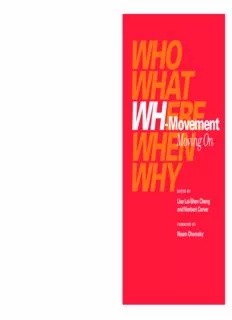
Wh-Movement: Moving On (Current Studies in Linguistics) PDF
Preview Wh-Movement: Moving On (Current Studies in Linguistics)
Cheng_pb.qxd 5/9/06 9:03 AM Page 1 WH L I N G U I S T I C S -Movement W WHO Moving On H Lisa Lai-Shen Cheng and Norbert Corver - EDITED BY M Noam Chomsky WHAT FOREWORD BY o v e Wh-movement—the phenomenon by which inter- CONTRIBUTORS m rogative words appear at the beginning of interrog- Brian Agbayani ative sentences—is one of the central displacement e operations of human language. Noam Chomsky’s Lisa Lai-Shen Cheng n WHERE 1977 paper “On Wh-Movement,” a landmark in the Sandra Chung t : study of wh-movement (and movement in general), Norbert Corver M showed that this computational operation is the Caterina Donati -Movement o basis of a variety of syntactic constructions that had Kleanthes K. Grohmann v previously been described in terms of construction- i Toru Ishii n WHEMNoving On specific rules. Taking Chomsky’s paper as a starting g point, the contributors to this collection reconsider a Heejeong Ko O number of the issues raised in “On Wh-Movement” Howard Lasnik n from the perspective of contemporary Minimalist Philip LeSourd syntactic theory (which explores the thesis that Chris H. Reintges human language is a system optimally designed to WHY Luigi Rizzi meet certain interface conditions imposed by other cognitive systems with which the language faculty Balázs Surányi interacts). They discuss such wh-movement issues Akira Watanabe as wh-phrases and pied-piping, the formation of Henrietta Yang A-bar chains and the copy theory of movement, C h cyclicity and locality of wh-movement, and the EDITED BY e typology of wh-constructions. By reconsidering core “A topic of everlasting importance n g Lisa Lai-Shen Cheng characteristics of the wh-movement operation first and interest, kept at the forefront a systematically discussed by Chomsky from the of the field by this fine collection. n and Norbert Corver d Minimalist perspective, this volume contributes to Some of the articles, by a good C the further development of the theory ofwh-move- mix of eminent and rising scholars, o ment and to the general theory of movement. r FOREWORD BY v have already attracted widespread e Lisa Lai-Shen Cheng is Professor of Linguistics at attention. Not to be missed.” r, Noam Chomsky e Leiden University. Norbert Corver is Professor of —C.-T. James Huang, Professor of d i Dutch Linguistics at Utrecht University. Linguistics, Harvard University to r s Current Studies in Linguistics 42 0-262-53279-4 978-0-262-53279-2 The MIT Press Massachusetts Institute of Technology Cambridge, Massachusetts 02142 http://mitpress.mit.edu Wh-Movement: Moving On Wh-Movement: Moving On edited by Lisa Lai-Shen Cheng and Norbert Corver The MIT Press Cambridge, Massachusetts London, England 62006MassachusettsInstituteofTechnology Allrights reserved. Nopart of thisbook maybereproduced inanyform by any electronic or mechanical means (including photocopying, recording, or informa- tionstorageandretrieval)withoutpermissioninwritingfromthepublisher. MIT Press books may be purchased at special quantity discounts for business or salespromotionaluse.Forinformation, [email protected] .edu or write to Special Sales Department, The MIT Press, 55 Hayward Street, Cambridge,MA02142. ThisbookwassetinTimesNewRomanon3B2byAscoTypesetters,HongKong, andprintedandboundintheUnitedStatesofAmerica. LibraryofCongressCataloging-in-PublicationData Wh-movement:movingon/editedbyLisaLai-ShenChengandNorbertCorver. p. cm.—(Currentstudiesinlinguistics;42) Includesbibliographicalreferencesandindex. ISBN0-262-03346-1(alk.paper)—ISBN0-262-53279-4(pbk.:alk.paper) 1.Grammar,Comparativeandgeneral—Interrogative. 2.Grammar, Comparativeandgeneral—Wordorder. 3.Grammar,Comparativeand general—Syntax. 4.Minimalisttheory(Linguistics). I.Cheng,LisaLai-Shen. II.Corver,Norbert,1963– III.Currentstudiesinlinguisticsseries;42. P299.I57W47 2006 415—dc22 2005058016 10 9 8 7 6 5 4 3 2 1 Contents Contributors vii Foreword ix NoamChomsky Acknowledgments xiii Chapter1 LinesofInquiryintoWh-Movement 1 LisaLai-ShenChengandNorbert Corver PARTI Wh-PhrasesandPied-Piping 19 Chapter2 OnWh-HeadMovement 21 CaterinaDonati Chapter3 ThePied-PiperFeature 47 AkiraWatanabe Chapter4 Pied-Piping,FeatureMovement,and BrianAgbayani Wh-Subjects 71 PARTII A¯-ChainsandCopyTheory 95 Chapter5 OntheFormofChains:Criterial LuigiRizzi PositionsandECPE¤ects 97 Chapter6 OnOvertandCovertWh-andRelative HenriettaYang MovementinHindiandPunjabi 135 vi Contents Chapter7 Movement,Wh-Agreement,and ChrisH.Reintges,PhilipLeSourd, ApparentWh-in-situ 165 andSandraChung PARTIII CyclicityandLocality 195 Chapter8 ConceptionsoftheCycle 197 HowardLasnik Chapter9 OntheRelaxationofIntervention ToruIshii E¤ects 217 PARTIV Wh-Constructions 247 Chapter10 TopIssuesinQuestions:Topics– KleanthesK.Grohmann Topicalization–Topicalizability 249 Chapter11 MechanismsofWh-Saturationand Bala´zsSura´nyi InterpretationinMultipleWh- Movement 289 Chapter12 OntheStructuralHeightofReason HeejeongKo Wh-Adverbials:Acquisitionand Consequences 319 Index 351 Contributors Brian Agbayani Bala´zs Sura´nyi California StateUniversity, Fresno Hungarian Academy of Sciences Lisa Lai-Shen Cheng Akira Watanabe Leiden University University ofTokyo SandraChung Henrietta Yang University of California,Santa The University of Texas at Austin Cruz Norbert Corver UtrechtUniversity Caterina Donati University of Urbino Kleanthes K. Grohmann University of Cyprus Toru Ishii MeijiUniversity Heejeong Ko Stony Brook University Howard Lasnik University of Maryland PhilipLeSourd Indiana University Chris H. Reintges Leiden University/ULCL LuigiRizzi University of Siena Foreword Noam Chomsky This outstanding collection of papers is an impressive testimonial to the great advances in empirical knowledge and theoretical understanding in recent years. Many of the questions addressed here could not even have been posed, let alone answered, not very long ago. Nevertheless, many of the earliest questions remain, though in quite new forms, as attested by a number of the papers here: questions about the nature of cyclic/ compositional operations; locality; what moves (heads? features?); the nature of the obscure issue of pied-piping; projection under movement; varieties of marking of intermediate positions; whether movement is implicated at all where that has often been assumed, rather than other relations with base generation; and many other questions that have a familiar ring. Old chestnuts often have hard shells. That should hardly surprise us in a field that barely existed 50 years ago, despite a tradition going back thousands of years. Thebasicissueaddressedinthesepapersistheubiquitousphenomenon of displacement: basically, the fact that expressions are produced/heard in one position but interpreted as well in other positions—positions in which, furthermore, similar expressions (or even the same ones) appear and are interpreted in terms of natural local configurations. That much is uncontroversial. How to deal with the phenomenon, however, is any- thingbut uncontroversial. Within generative grammar in the modern sense, the earliest work that tried to account for displacement, 50 years ago, did not have rules of movement at all. Rather, such phenomena as wh-displacement were for- mulated in terms of permutation. Thus, sentences (1) and (2) were in e¤ect derived by permutation of X and a in the syntactic object X-a-Y, where a is the element displaced to the front; (2) was derived from the counterpart of (1) with who replacing Mary (technically, the form under- lying it).
Description: